Wideband Eight-Antenna Array Designs for 5G Smartphone Applications
Abstract
:1. Introduction
- It offers a streamlined manufacturing process and cost savings by printing the loop antenna structure solely on one side of the substrate. In comparison, the loop antenna described in [46] necessitates printing on both sides.
- It can produce three distinct loop modes (at 3.6, 4.0, and 5.1 GHz), resulting in a broader operating band width compared to [46].
- The CC demonstrated is an impressive 37–40 bps/Hz, just marginally below the theoretical upper limit of 46 bps/Hz.
2. Antenna Geometry and Design Evolution
3. Findings and Analysis
4. Hand Effect on the Proposed Eight-Antenna Array
4.1. Single-Hand Mode (SHM)
4.2. Double-Hand Mode (DHM)
5. Battery Component Simulation
6. Performances Comparison
7. Indoor Throughput Measurement
8. Conclusions
Author Contributions
Funding
Data Availability Statement
Acknowledgments
Conflicts of Interest
References
- Sharawi, M.S. Printed Multi-Band MIMO Antenna Systems and Their Performance Metrics [Wireless Corner]. IEEE Antennas Propag. Mag. 2013, 55, 218–232. [Google Scholar] [CrossRef]
- Kulkarni, J.; Alharbi, A.G.; Desai, A.; Sim, C.-Y.; Poddar, A. Design and Analysis of Wideband Flexible Self-Isolating MIMO Antennas for Sub-6 GHz 5G and WLAN Smartphone Terminals. Electronics 2021, 10, 3031. [Google Scholar] [CrossRef]
- Parkvall, S.; Dahlman, E.; Furuskar, A.; Frenne, M. NR: The New 5G Radio Access Technology. IEEE Commun. Stand. Mag. 2017, 1, 24–30. [Google Scholar] [CrossRef]
- Naik, G.; Park, J.-M.; Ashdown, J.; Lehr, W. Next Generation Wi-Fi and 5G NR-U in the 6 GHz Bands: Opportunities and Challenges. IEEE Access 2020, 8, 153027–153056. [Google Scholar] [CrossRef]
- Lu, J.-Y.; Wong, K.-L.; Li, W.-Y. Compact eight-antenna array in the smartphone for the 3.5-GHz LTE 8 × 8 MIMO operation. In Proceedings of the IEEE 5th Asia-Pacific Conference Antennas and Propagation (APCAP), Kaohsiung, Taiwan, 26–29 July 2016; pp. 323–324. [Google Scholar]
- Lu, J.-Y.; Chang, H.-J.; Wong, K.-L. 10-antenna array in the smartphone for the 3.6 GHz MIMO operation. In Proceedings of the IEEE International Symposium on Antennas and Propagation and USNC-URSI Radio Science Meeting (AP-S/URSI 2015), Vancouver, BC, Canada, 19–24 July 2015; pp. 1220–1221. [Google Scholar]
- Shi, H.; Zhang, X.; Li, J.; Jia, P.; Chen, J.; Zhang, A. 3.6-GHz eight-antenna MIMO array for mobile terminal applications. AEU-Int. J. Electron. Commun. 2018, 95, 342–348. [Google Scholar] [CrossRef]
- Ban, Y.-L.; Li, C.; Sim, C.-Y.-D.; Wu, G.; Wong, K.-L. 4G/5G Multiple Antennas for Future Multi-Mode Smartphone Applications. IEEE Access 2016, 4, 2981–2988. [Google Scholar] [CrossRef]
- Al-Hadi, A.A.; Ilvonen, J.; Valkonen, R.; Viikari, V. Eight-element antenna array for diversity and mimo mobile terminal in LTE 3500 MHz band. Microw. Opt. Technol. Lett. 2014, 56, 1323–1327. [Google Scholar] [CrossRef]
- Wong, K.-L.; Tsai, C.-Y.; Lu, J.-Y. Two Asymmetrically Mirrored Gap-Coupled Loop Antennas as a Compact Building Block for Eight-Antenna MIMO Array in the Future Smartphone. IEEE Trans. Antennas Propag. 2017, 65, 1765–1778. [Google Scholar] [CrossRef]
- Li, Y.; Sim, C.-Y.-D.; Luo, Y.; Yang, G. 12-Port 5G massive MIMO antenna array in Sub-6GHz mobile handset for LTE bands 42/43/46 applications. IEEE Access 2017, 6, 344–354. [Google Scholar] [CrossRef]
- Li, Y.; Yang, G. Dual-mode and triple-band 10-antenna handset array and its multiple-input multiple-output performance evaluation in 5G. Int. J. RF Microw. Comput. Aided Eng. 2019, 29, e21538. [Google Scholar] [CrossRef]
- Wang, H.; Zhang, R.; Luo, Y.; Yang, G. Compact Eight-Element Antenna Array for Triple-Band MIMO Operation in 5G Mobile Terminals. IEEE Access 2020, 8, 19433–19449. [Google Scholar] [CrossRef]
- Wong, K.-L.; Lu, J.-Y.; Chen, L.-Y.; Li, W.-Y.; Ban, Y.-L. 8-antenna and 16-antenna arrays using the quad-antenna linear array as a building block for the 3.5-GHz LTE MIMO operation in the smartphone. Microw. Opt. Technol. Lett. 2015, 58, 174–181. [Google Scholar] [CrossRef]
- Jiang, W.; Liu, B.; Cui, Y.; Hu, W. High-Isolation Eight-Element MIMO Array for 5G Smartphone Applications. IEEE Access 2019, 7, 34104–34112. [Google Scholar] [CrossRef]
- Wang, M.; Xu, B.; Li, Y.; Luo, Y.; Zou, H.; Yang, G. Multiband multiple-input multiple-output antenna with high isolation for future 5G smartphone applications. Int. J. RF Microw. Comput. Eng. 2019, 29, e21758. [Google Scholar] [CrossRef]
- Hu, W.; Qian, L.; Gao, S.; Wen, L.-H.; Luo, Q.; Xu, H.; Liu, X.; Liu, Y.; Wang, W. Dual-Band Eight-Element MIMO Array Using Multi-Slot Decoupling Technique for 5G Terminals. IEEE Access 2019, 7, 153910–153920. [Google Scholar] [CrossRef]
- Li, Y.; Sim, C.-Y.-D.; Luo, Y.; Yang, G. Metal-frame-integrated eight-element multiple-input multiple-output antenna array in the long term evolution bands 41/42/43 for fifth generation smartphone. Int. J. RF Microw. Comput. Aided Eng. 2019, 29, e21495. [Google Scholar] [CrossRef]
- Zou, H.; Li, Y.; Xu, B.; Luo, Y.; Wang, M.; Yang, G. A dual-band eight-antenna multi-input multi-output array for 5G metal-framed smartphones. Int. J. RF Microw. Comput. Aided Eng. 2019, 29, e21745. [Google Scholar] [CrossRef]
- Hu, W.; Liu, X.; Gao, S.; Wen, L.-H.; Qian, L.; Feng, T.; Xu, R.; Fei, P.; Liu, Y. Dual-Band Ten-Element MIMO Array Based on Dual-Mode IFAs for 5G Terminal Applications. IEEE Access 2019, 7, 178476–178485. [Google Scholar] [CrossRef]
- Serghiou, D.; Khalily, M.; Singh, V.; Araghi, A.; Tafazolli, R. Sub-6 GHz Dual-Band 8 × 8 MIMO Antenna for 5G Smartphones. IEEE Antennas Wirel. Propag. Lett. 2020, 19, 1546–1550. [Google Scholar] [CrossRef]
- Chen, S.-C.; Chou, L.-C.; Hsu, C.-I.G.; Li, S.-M. Compact Sub-6-GHz Four-Element MIMO Slot Antenna System for 5G Tablet Devices. IEEE Access 2020, 8, 154652–154662. [Google Scholar] [CrossRef]
- Sun, L.; Feng, H.; Li, Y.; Zhang, Z. Tightly arranged orthogonal mode antenna for 5G MIMO mobile terminal. Microw. Opt. Technol. Lett. 2018, 60, 1751–1756. [Google Scholar] [CrossRef]
- Sun, L.; Feng, H.; Li, Y.; Zhang, Z. Compact 5G MIMO Mobile Phone Antennas with Tightly Arranged Orthogonal-Mode Pairs. IEEE Trans. Antennas Propag. 2018, 66, 6364–6369. [Google Scholar] [CrossRef]
- Abdullah, M.; Kiani, S.H.; Iqbal, A. Eight Element Multiple-Input Multiple-Output (MIMO) Antenna for 5G Mobile Applications. IEEE Access 2019, 7, 134488–134495. [Google Scholar] [CrossRef]
- Zou, H.; Li, Y.; Xu, B.; Chen, Y.; Jin, H.; Yang, G.; Luo, Y. Dual-Functional MIMO Antenna Array with High Isolation for 5G/WLAN Applications in Smartphones. IEEE Access 2019, 7, 167470–167480. [Google Scholar] [CrossRef]
- Parchin, N.O.; Al-Yasir, Y.I.; Basherlou, H.J.; Abd-Alhameed, R.A.; Noras, J.M. Orthogonally dual-polarised MIMO antenna array with pattern diversity for use in 5G smartphones. IET Microw. Antennas Propag. 2020, 14, 457–467. [Google Scholar] [CrossRef]
- Han, C.-Z.; Xiao, L.; Chen, Z.; Yuan, T. Co-Located Self-Neutralized Handset Antenna Pairs with Complementary Radiation Patterns for 5G MIMO Applications. IEEE Access 2020, 8, 73151–73163. [Google Scholar] [CrossRef]
- Piao, H.; Jin, Y.; Qu, L. A Compact and Straightforward Self-Decoupled MIMO Antenna System for 5G Applications. IEEE Access 2020, 8, 129236–129245. [Google Scholar] [CrossRef]
- Wong, K.L.; Lin, B.W.; Li, W.Y. Dual-band dual inverted-F/loop antennas as a compact decoupled building block for forming eight 3.5/5.8-GHz MIMO antennas in the future smartphone. Microw. Opt. Technol. Lett. 2017, 59, 2715–2721. [Google Scholar] [CrossRef]
- Ren, Z.; Zhao, A.; Wu, S. MIMO Antenna with Compact Decoupled Antenna Pairs for 5G Mobile Terminals. IEEE Antennas Wirel. Propag. Lett. 2019, 18, 1367–1371. [Google Scholar] [CrossRef]
- Ren, Z.; Zhao, A. Dual-Band MIMO Antenna with Compact Self-Decoupled Antenna Pairs for 5G Mobile Applications. IEEE Access 2019, 7, 82288–82296. [Google Scholar] [CrossRef]
- Zhao, A.; Ren, Z. Multiple-input and multiple-output antenna system with self-isolated antenna element for fifth-generation mobile terminals. Microw. Opt. Technol. Lett. 2019, 61, 20–27. [Google Scholar] [CrossRef]
- Zhao, X.; Yeo, S.P.; Ong, L.C. Decoupling of Inverted-F Antennas with High-Order Modes of Ground Plane for 5G Mobile MIMO Platform. IEEE Trans. Antennas Propag. 2018, 66, 4485–4495. [Google Scholar] [CrossRef]
- Deng, C.; Liu, D.; Lv, X. Tightly Arranged Four-Element MIMO Antennas for 5G Mobile Terminals. IEEE Trans. Antennas Propag. 2019, 67, 6353–6361. [Google Scholar] [CrossRef]
- Hong, W.; Sim, C. Microwave and Millimeter-Wave Antenna Design for 5G Smartphone Applications; Wiley: Hoboken, NJ, USA, 2023; ISBN 978-1-394-18244-2. [Google Scholar]
- Sun, L.; Li, Y.; Zhang, Z.; Feng, Z. Wideband 5G MIMO Antenna with Integrated Orthogonal-Mode Dual-Antenna Pairs for Metal-Rimmed Smartphones. IEEE Trans. Antennas Propag. 2020, 68, 2494–2503. [Google Scholar] [CrossRef]
- Cai, Q.; Li, Y.; Zhang, X.; Shen, W. Wideband MIMO Antenna Array Covering 3.3–7.1 GHz for 5G Metal-Rimmed Smartphone Applications. IEEE Access 2019, 7, 142070–142084. [Google Scholar] [CrossRef]
- Chen, H.-D.; Tsai, Y.-C.; Sim, C.-Y.; Kuo, C. Broadband Eight-Antenna Array Design for Sub-6 GHz 5G NR Bands Metal-Frame Smartphone Applications. IEEE Antennas Wirel. Propag. Lett. 2020, 19, 1078–1082. [Google Scholar] [CrossRef]
- Yuan, X.-T.; He, W.; Hong, K.-D.; Han, C.-Z.; Chen, Z.; Yuan, T. Ultra-Wideband MIMO Antenna System with High Element-Isolation for 5G Smartphone Application. IEEE Access 2020, 8, 56281–56289. [Google Scholar] [CrossRef]
- Sim, C.-Y.; Liu, H.-Y.; Huang, C.-J. Wideband MIMO Antenna Array Design for Future Mobile Devices Operating in the 5G NR Frequency Bands n77/n78/n79 and LTE Band 46. IEEE Antennas Wirel. Propag. Lett. 2020, 19, 74–78. [Google Scholar] [CrossRef]
- Wong, K.-L.; Chen, Y.-H.; Li, W.-Y. Decoupled compact ultra-wideband MIMO antennas covering 3300~6000 MHz for the fifth-generation mobile and 5GHz-WLAN operations in the future smartphone. Microw. Opt. Technol. Lett. 2018, 60, 2345–2351. [Google Scholar] [CrossRef]
- Yuan, X.-T.; Chen, Z.; Gu, T.; Yuan, T. A Wideband PIFA-Pair-Based MIMO Antenna for 5G Smartphones. IEEE Antennas Wirel. Propag. Lett. 2021, 20, 371–375. [Google Scholar] [CrossRef]
- Sun, L.; Li, Y.; Zhang, Z. Wideband Decoupling of Integrated Slot Antenna Pairs for 5G Smartphones. IEEE Trans. Antennas Propag. 2021, 69, 2386–2391. [Google Scholar] [CrossRef]
- Zhao, A.; Ren, Z. Size Reduction of Self-Isolated MIMO Antenna System for 5G Mobile Phone Applications. IEEE Antennas Wirel. Propag. Lett. 2019, 18, 152–156. [Google Scholar] [CrossRef]
- Zhao, A.; Ren, Z. Wideband MIMO Antenna Systems Based on Coupled-Loop Antenna for 5G N77/N78/N79 Applications in Mobile Terminals. IEEE Access 2019, 7, 93761–93771. [Google Scholar] [CrossRef]
- Speag. SHO-V3RW-C/LW-C and SHO3TO6-V3RW-C/LW-C. Available online: https://speag.swiss/products/em-phantoms/ctia-sub-3/sho-v3rw-clw-c/ (accessed on 1 July 2024).

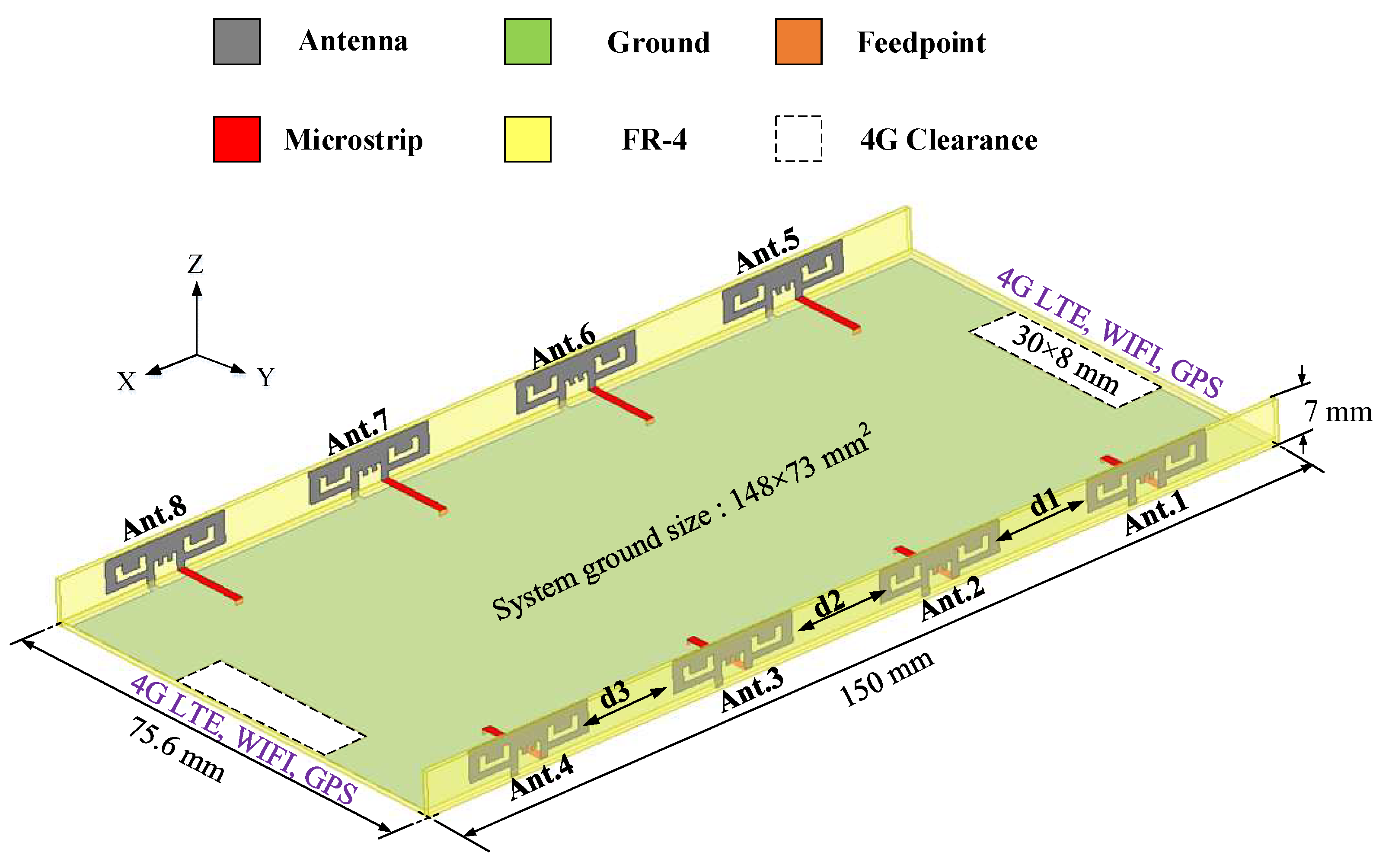
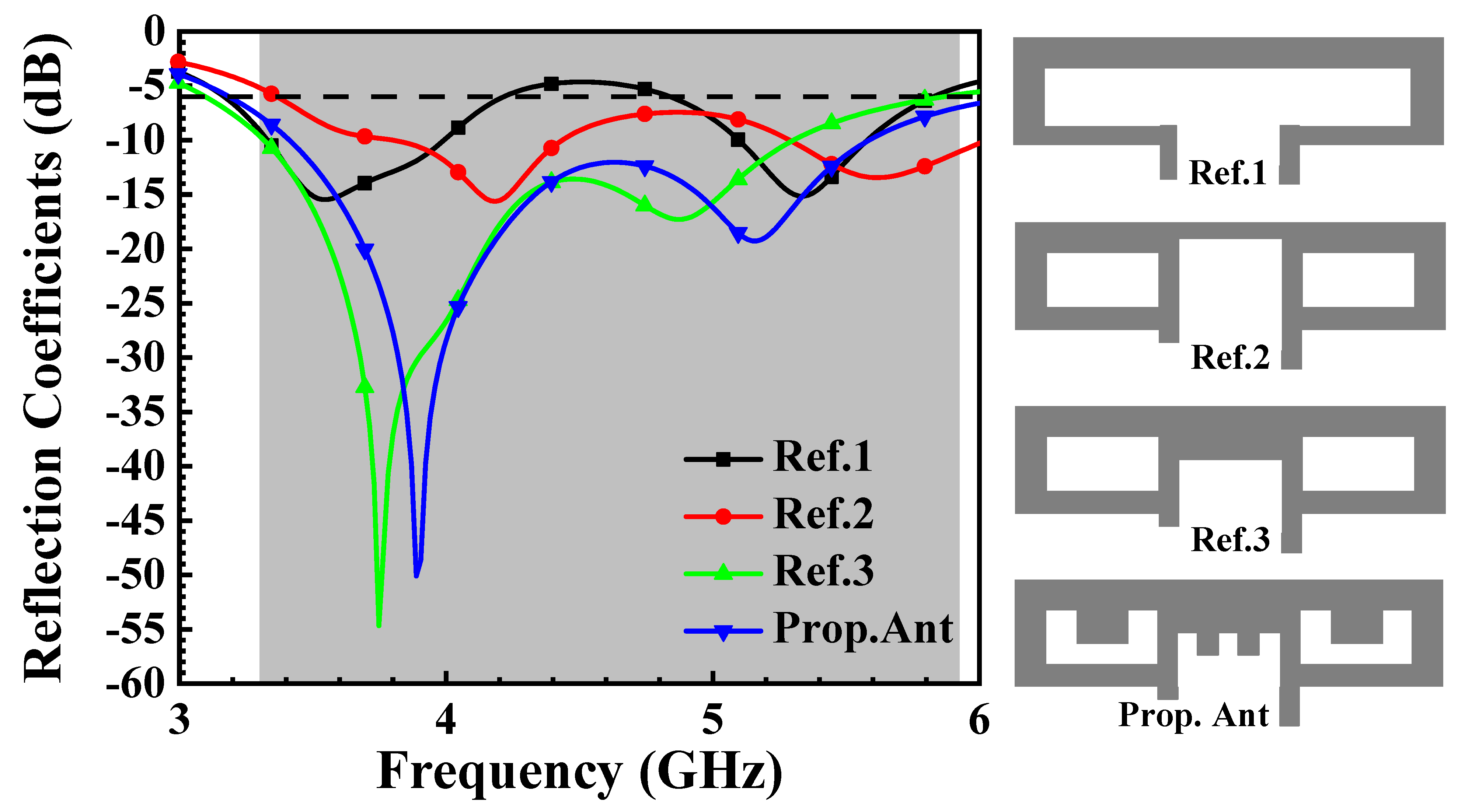
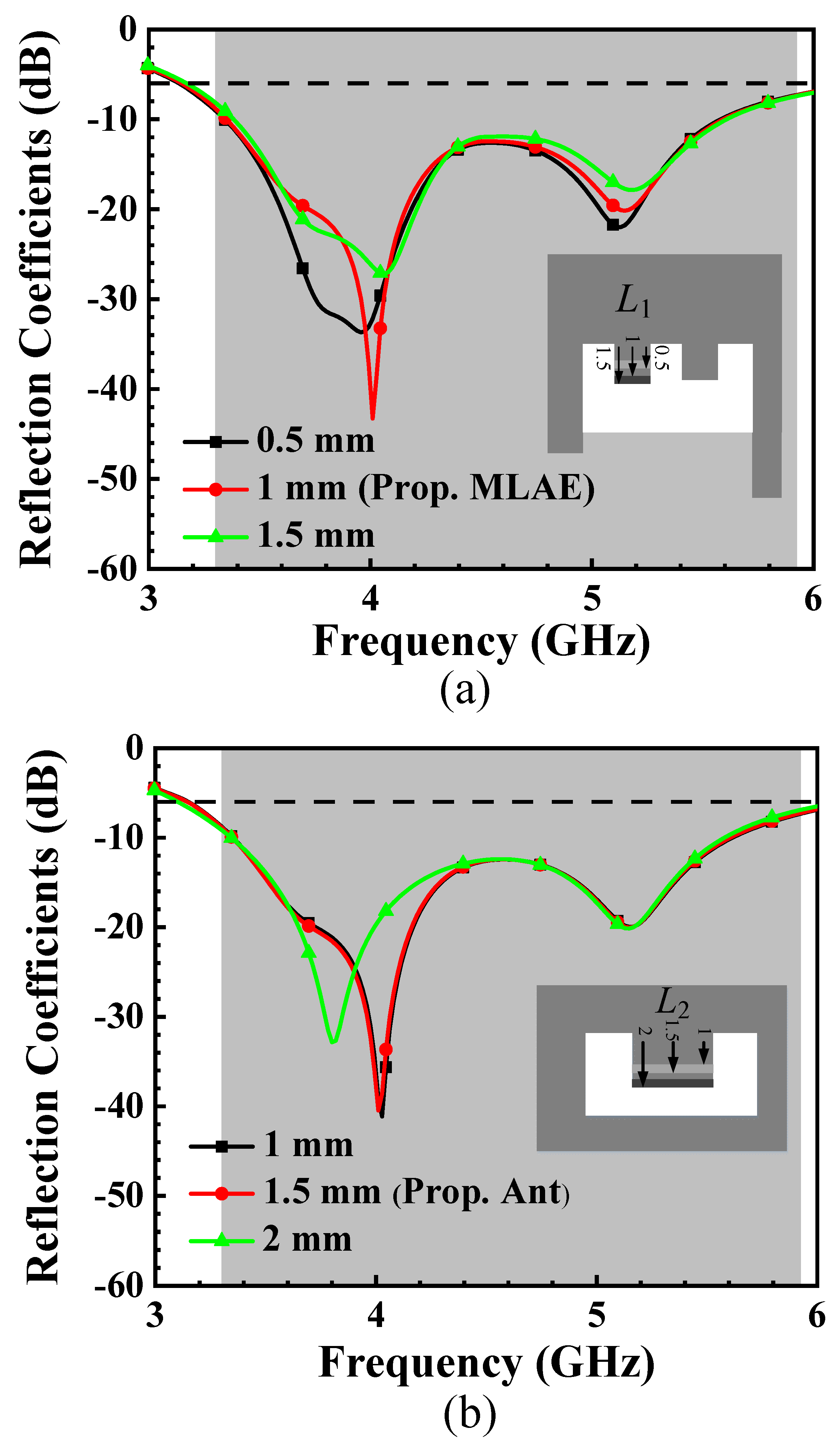


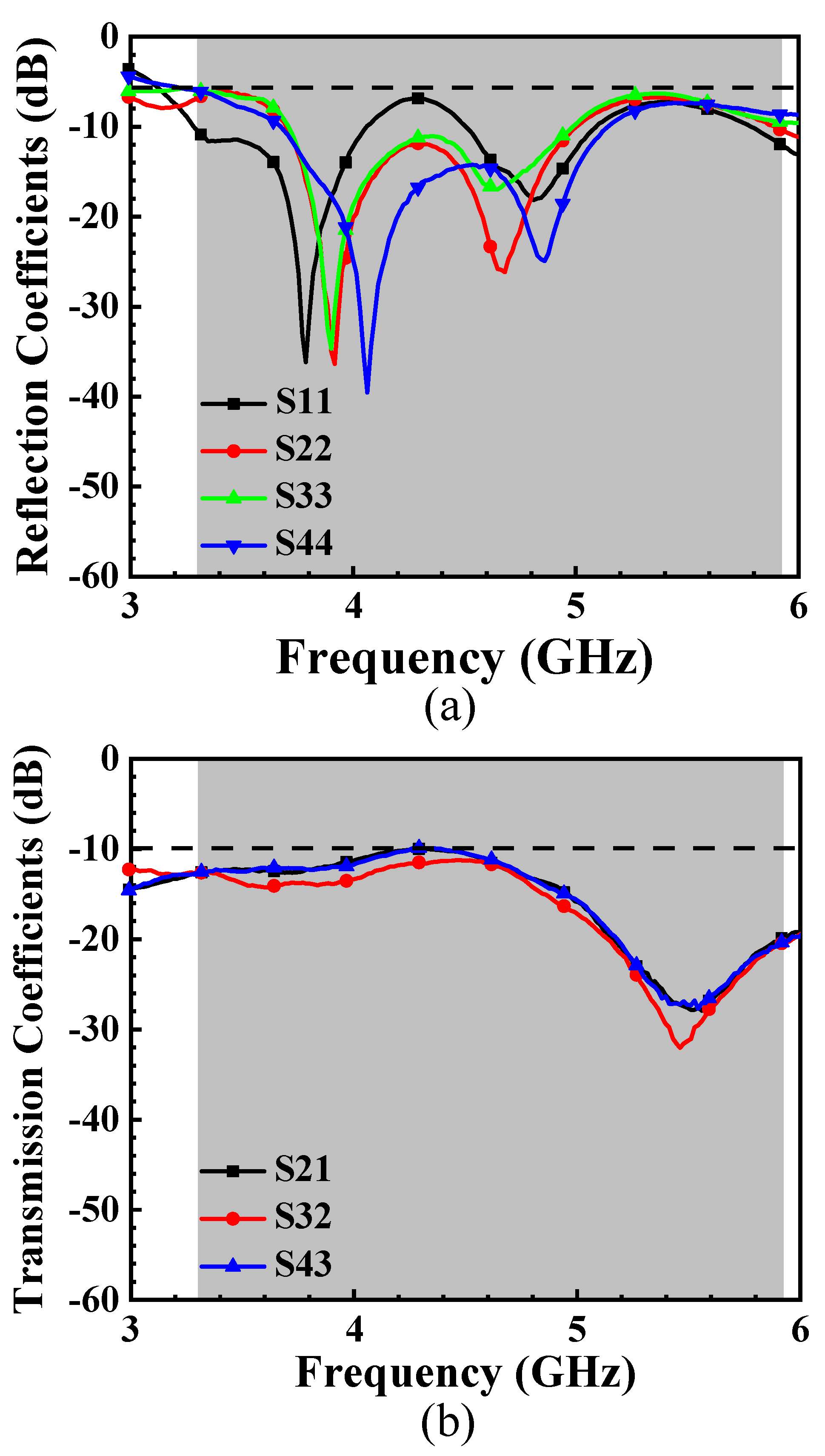

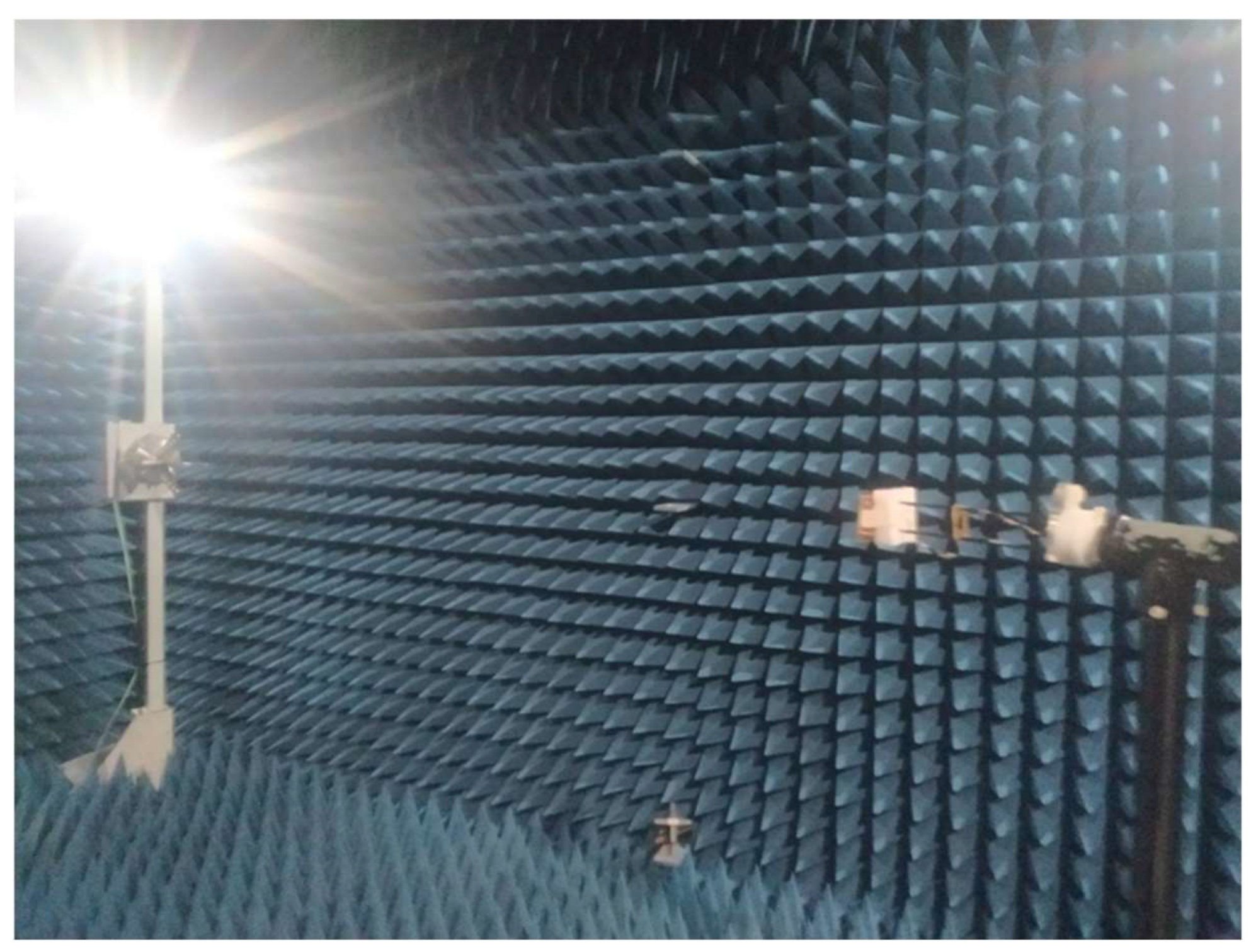

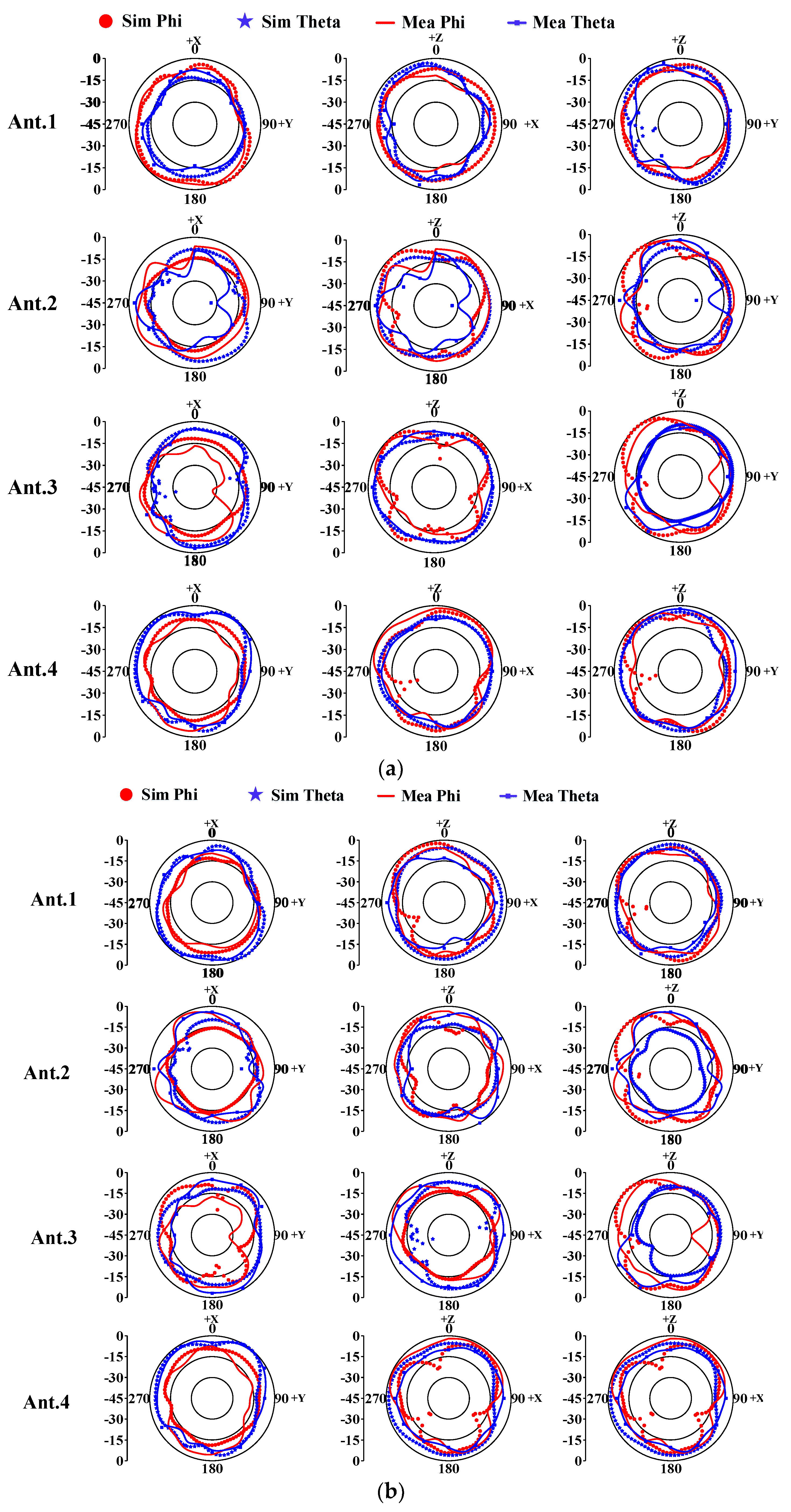
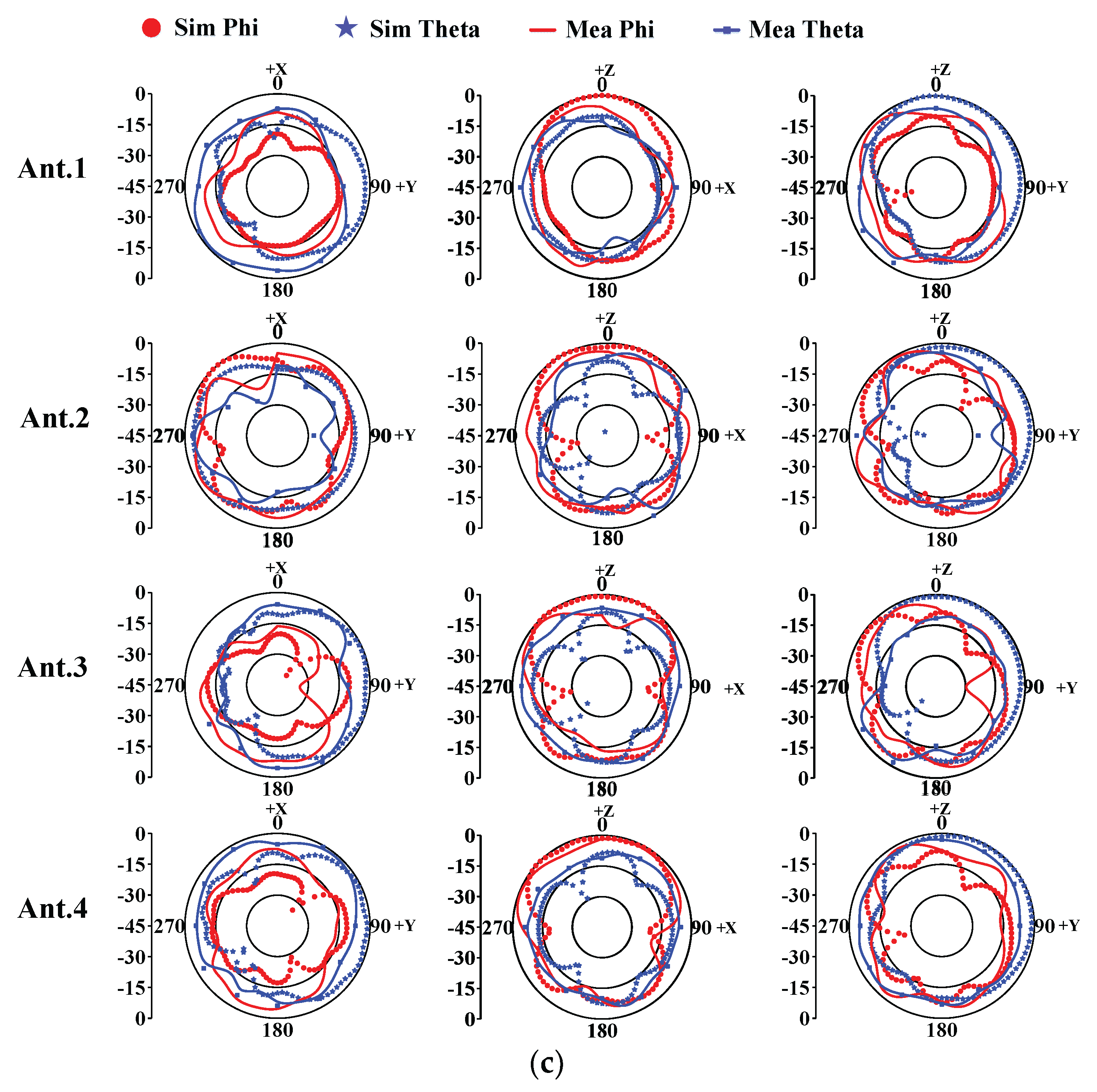
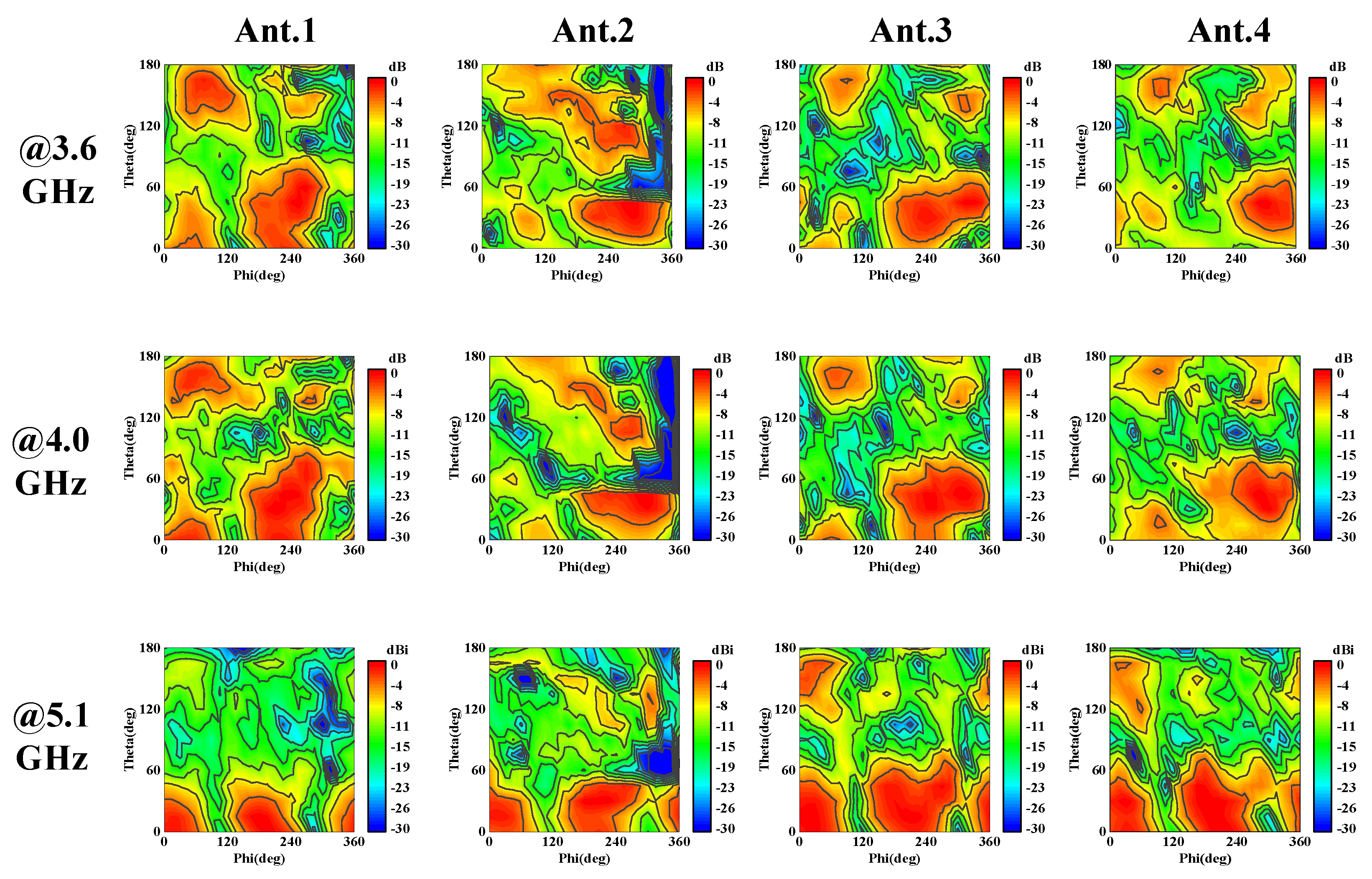







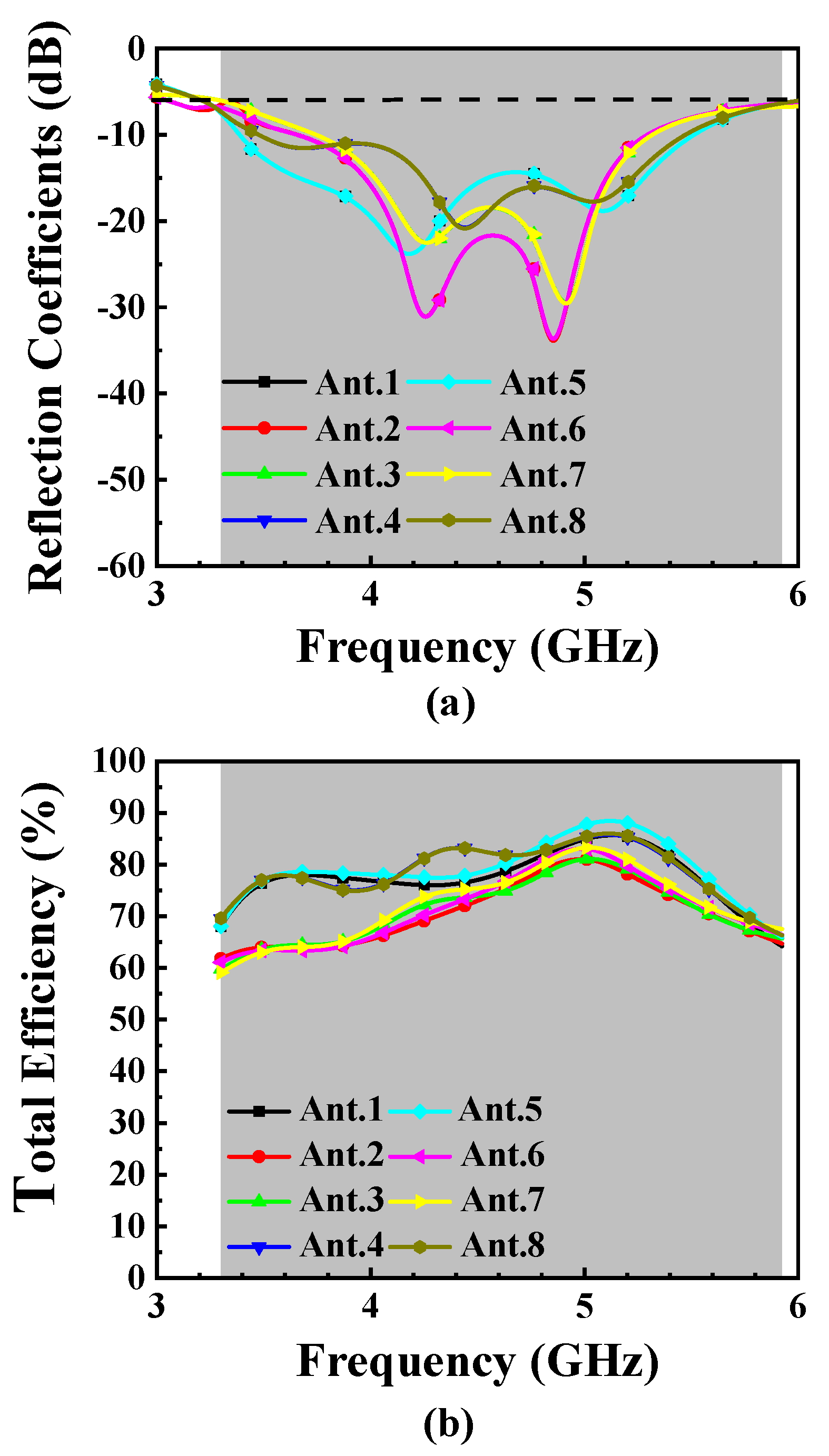

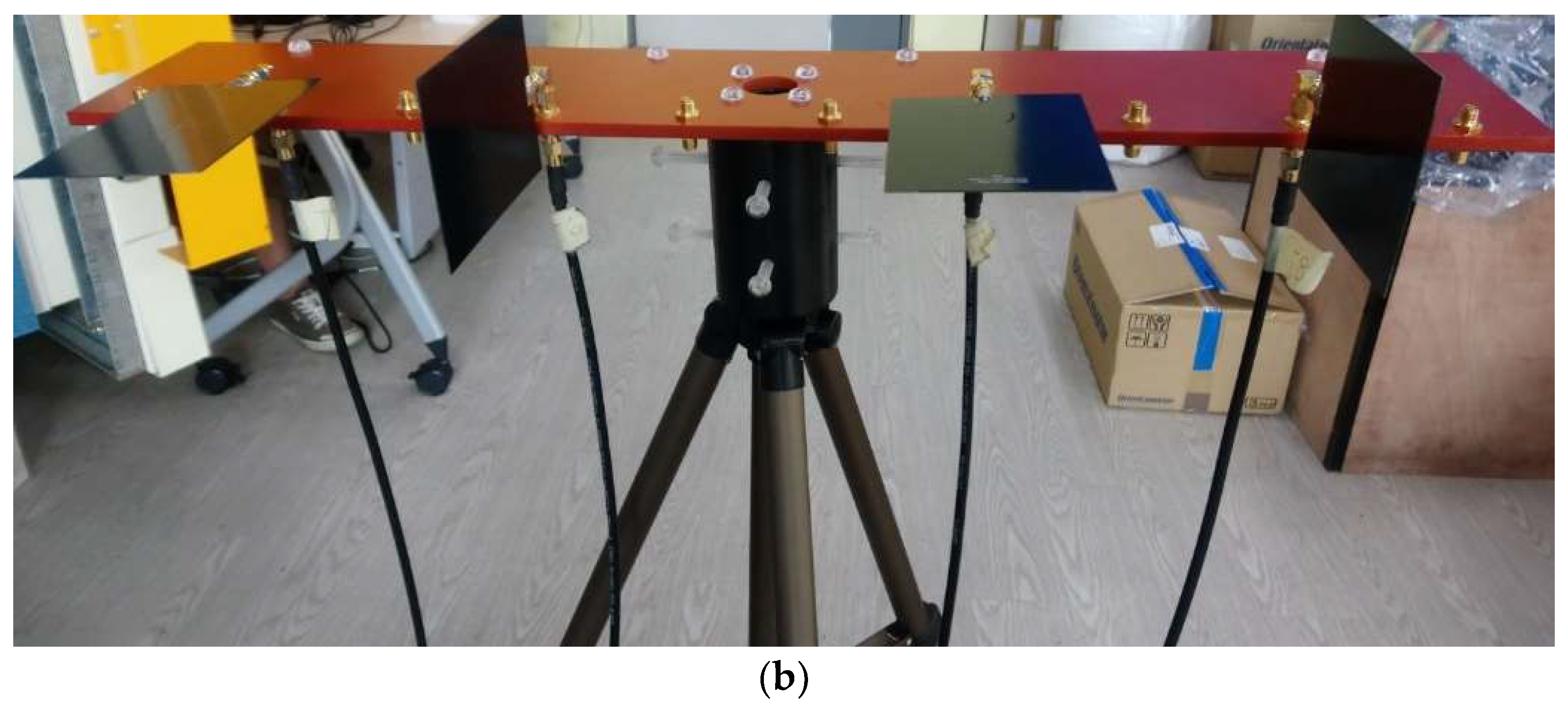
| Ref. | Ant. Size (mm2) | Frame Profile (mm) | BW (GHz) | Iso. (dB) | ECC | Peak Channel Capacity (bps/Hz) |
|---|---|---|---|---|---|---|
| [39] ^ | 2 × 7frame 9 × 2ground slot | 7 | 3.2–5.93 10-dB | >12 | <0.1 | 43.93 (8 × 8) |
| [40] ^ | 17 × 7frame | 7 | 3.3–6 6-dB | >18 | <0.05 | NA |
| [41] | 13.9 × 6 | 7 | 3.1–6.0 10-dB | >10 | <0.1 | 39 (8 × 8) |
| [42] | 16 × 5 | 7 | 3.3–6 6-dB | >12 | 0 | NA |
| [43] | 30 × 6.2 * | 7 | 3.3–7.5 6-dB | >10 | <0.06 | NA |
| [44] | 28 × 7 & | 5 | 3.3–5 6-dB | >10 | <0.3 | NA |
| [46] | 21.5 × 6 | 7 | 3.3–5 6-dB | >14.5 | <0.1 | 38 (8 × 8) |
| PA | 21 × 6 | 7 | 3.1–6 6-dB | >10 | <0.1 | 40 (8 × 8) |
Disclaimer/Publisher’s Note: The statements, opinions and data contained in all publications are solely those of the individual author(s) and contributor(s) and not of MDPI and/or the editor(s). MDPI and/or the editor(s) disclaim responsibility for any injury to people or property resulting from any ideas, methods, instructions or products referred to in the content. |
© 2024 by the authors. Licensee MDPI, Basel, Switzerland. This article is an open access article distributed under the terms and conditions of the Creative Commons Attribution (CC BY) license (https://creativecommons.org/licenses/by/4.0/).
Share and Cite
Huang, G.-L.; Chang, T.-Y.; Sim, C.-Y.-D. Wideband Eight-Antenna Array Designs for 5G Smartphone Applications. Electronics 2024, 13, 2995. https://doi.org/10.3390/electronics13152995
Huang G-L, Chang T-Y, Sim C-Y-D. Wideband Eight-Antenna Array Designs for 5G Smartphone Applications. Electronics. 2024; 13(15):2995. https://doi.org/10.3390/electronics13152995
Chicago/Turabian StyleHuang, Guan-Long, Ting-Yu Chang, and Chow-Yen-Desmond Sim. 2024. "Wideband Eight-Antenna Array Designs for 5G Smartphone Applications" Electronics 13, no. 15: 2995. https://doi.org/10.3390/electronics13152995





